
Low Maintenance Gardens – Better for Pollinators and People

Contributor
- Topics: Growing for Biodiversity
Autumn 2022
“I come out every day. It’s therapy, my meditation.” Janet’s young garden transformed from overgrown, invasive plants to mostly natives. The dailiness of her attention nourishes the becoming garden as much as it nourishes her. English ivy (Hedera helix) seedlings and creeping St. John’s wort (Hypericum calycinum) sprouts don’t stand a chance of re-invading under the attentive grasp of her gloved hands. After the heavy labor of clearing, grading, and planting, all that’s required are these peaceful passes. And once it’s well-established—with the bare ground covered in kinnikinnick (Arctostaphylos uva-ursi), stonecrops (Sedum), self-sowing Douglas meadowfoam (Limnanthes douglasii), and others—she’ll bend over to observe bees more often than to pull weeds. Her visits could still be daily, only shifting by a deepening of roots—her rootedness to the ground she inhabits mirroring the spreading roots of the new plants.
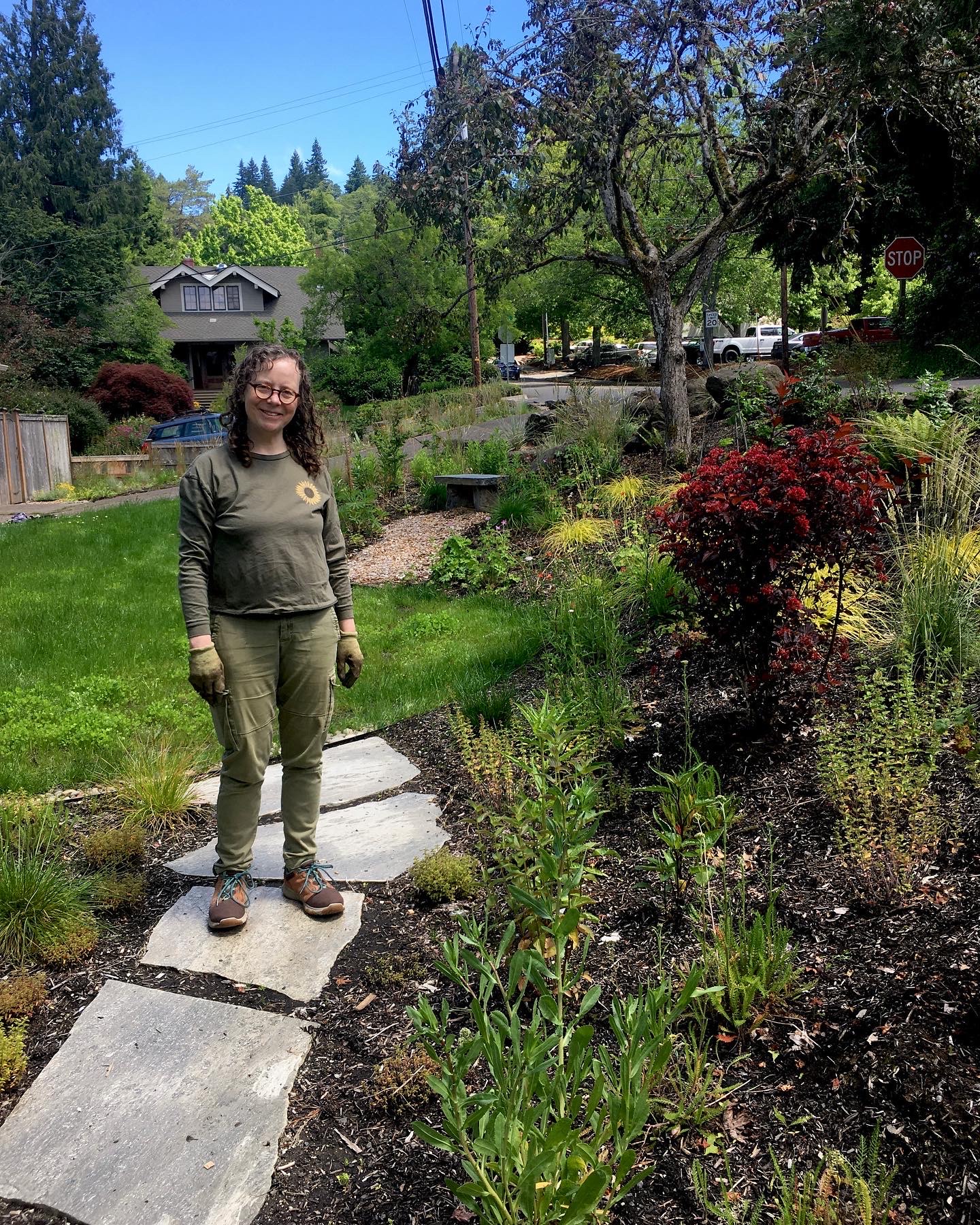
Four keys to low-maintenance gardening
What does maintenance mean? The American Heritage Dictionary points to work and an idea about a “proper” condition that those efforts seek to keep up. This desire to keep the garden in one particular version of itself suppresses the dynamism of nature in favor of a static state of perfection as defined by a singular human mind. Maintenance means controlling nature, containing and confining its will to proliferate, to rot, to grow, to harbor plant-eaters and soil-decomposers, pollinators and self-seeders.
In 25 years of designing gardens, I’ve only once heard someone brag that their style was high maintenance. The rest of us seek ease and enjoyment, not a long to-do list when we come home at the end of the day. We need restful weekends, a chance to play and to connect with our family, with nature, with what feeds us—not more work.
How do you achieve low maintenance and have something you’re proud of? How is it possible in the excessively weedy Pacific Northwest—where we are blessed with none to few killing frosts, and an abundance of rain equaled only by a bounty of Eurasian weed seeds—to enjoy the life of the lazy gardener? What does a low-maintenance landscape garden look like?
Some default to lawn and more lawn, where weeds weave into the grass, cut low with the regular racket of mower and blower and edger. Neat and tidy. Anyone can do it or pay a little to have it done. It’s done. The lawn is mown. Next week, do it again, and again, and again, forever. You know this is not a garden. You know this is not habitat for birds and pollinators, not beautiful with diversity, not compelling with seasonal changes. You can do better than lawn.
If you picture parking-lot plants or a sea of rock mulch devoid of life, you need more examples, because those scenes are not gardens either, are not full of life and all the richness that a true garden offers.
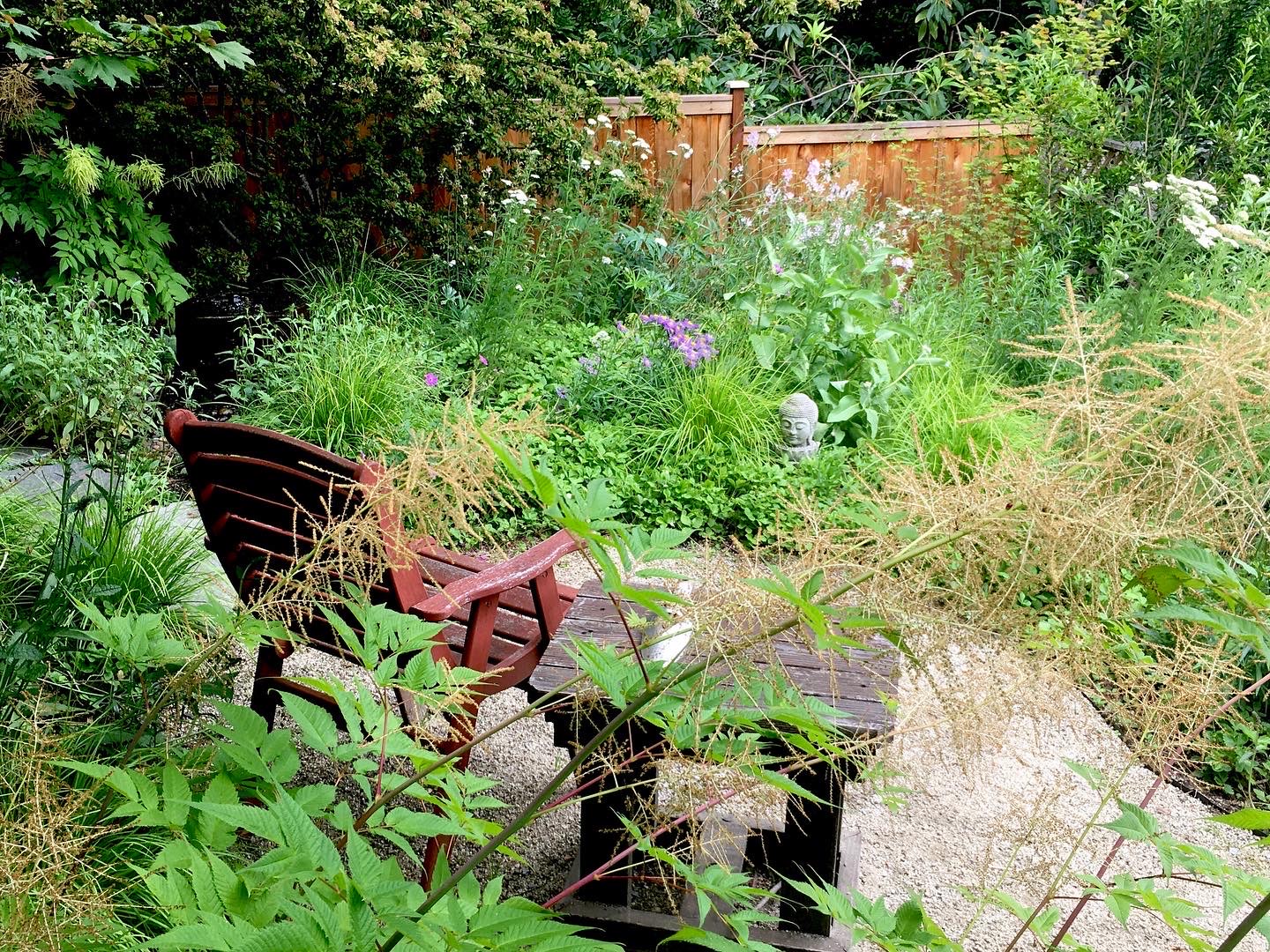
Imagine instead a place with welcoming paths, where plants layer and weave and buzz with delight, a place to experience, as Janet does, a meditative connection with nature. Here, I offer four keys to this kind of low-maintenance gardening.
Embrace mess, release control

“It’s a lot of work, definitely not a low-maintenance garden,” Mark tells me after describing the pruning, tree trimming, and leaf debris he handles completely by himself. Inspired by the stark beauty of the Sand and Stone Garden at the Portland Japanese Garden, Mark imagines something similar for his place—clean, orderly, peaceful. Seeking this, he’s out regularly blowing leaves, clearing debris, making his treed yard neat and tidy. Jennifer, his wife, is moved to respond to climate change and species decline. She sits on boards, hosts fundraisers, and educates herself about habitat loss and the importance of native plants. Her daily garden strolls inspire, but she senses something lacking, an opportunity for improvement.
When you admire a garden for its order, its tidiness, its perfect edges and lack of leaf litter, what you’re admiring is control of nature. And that control takes a lot of work. The Portland Japanese Garden has a full-time staff to keep the aesthetic that Mark would like to emulate. It takes patience, practice, and a fair bit of strength to rake the Sand and Stone Garden. Yet Mark would like to work less in his yard, rather than more. And Jennifer would like a garden that supports life. Neat and tidy takes work while sacrificing habitat. Everything from unseen beneficial decomposers to the most treasured songbird depends on debris for their home. Dead material in the garden is shelter, food, nest material, a buffet for someone who could call your garden home.
Death needs to be in the air for us to be fully alive.
—Charles Foster (2016)
The first key to low-maintenance gardening is a fundamental perspective shift: embracing a bit of debris, learning to see dead stuff as beautiful rather than as work. The standing dead snag is an easy place to start. You know that’s a favorite spot for the woodpeckers and cavity nesters. On a smaller scale, the standing stalks of perennials provide the same services for native bees. Valuing nature begins to mean valuing death as a giver of life. You turn your leaf blower off, get on your knees, and peer into the mysteries underfoot.

Smoothness, it turns out, is a dubious virtue, since it’s often the unsmoothed textures of life that make it livable, helping nurture the relationships that are crucial for mental and physical health, and for the resilience of our communities.
—Oliver Burkeman (2021)
Oliver Burkeman writes about human relationships and the truth that messiness is integral to the wellbeing of our species. What’s true of human nature is true, too, in the life of your garden. Remember that your garden is an ecosystem, and that an ecosystem is a place of relationships, of beings and processes interacting, bumping into each other, ebbing and flowing through the cycle of the year. Like the joy that arises from chance encounters with others in your day, the unplanned moments in your garden’s ecology are full of meaning, rich with life in all its messiness and beauty.
You get good relationships by relating, which takes time.
—Charles Foster (2016)
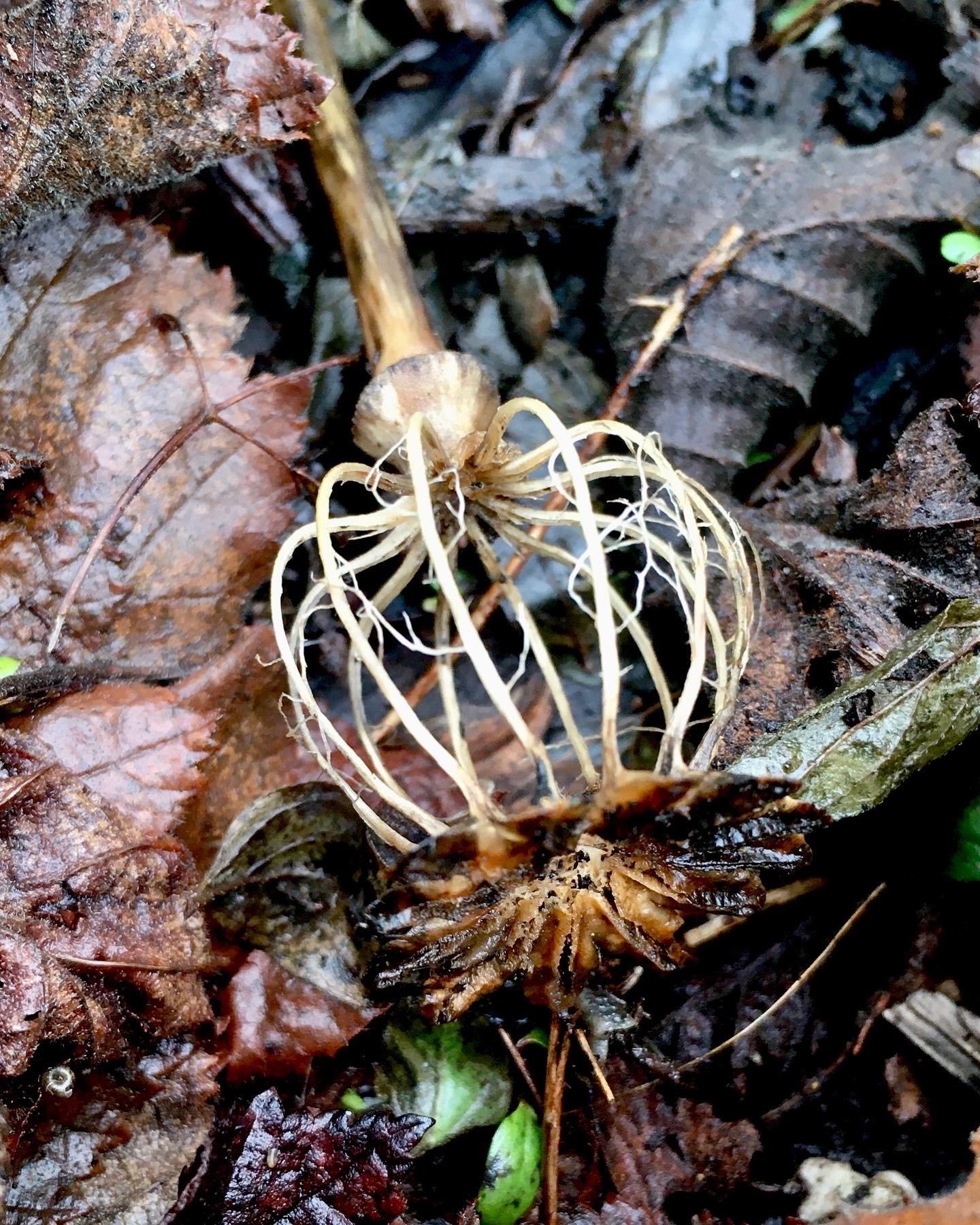
What does this mean for the activities you undertake to tend your yard? You ease up on the impulse to control in favor of more enjoyment. Less mowing and blowing, more observing and wonder. Relationships aren’t the exclusive realm of humanity. You can include miner bees, ground beetles, song sparrows, and even fungal mycelium in your community.
SIGN UP FOR OUR FREE MONTHLY NEWSLETTER
Expanding your connections this way fosters what psychotherapists call a second-order change (Burkeman 2021). It reframes everything. It’s the uncertainties of relationships that give meaning. In your habitat garden, chance plant combinations delight and aphids attract never-seen-before birds like the black-masked common yellowthroat (Geothlypis trichas). Unplanned species interactions are the expression of life. That’s why I suggest that the first step to creating a low-maintenance garden is to shift your perspective. Seek inspiration from complex and resilient natural areas. Highly maintained botanical gardens are an art form worthy of admiration, rather than imitation.

Respect boundaries, make great paths
Richard warily commented on the fullness, the “flourishing” of his summer garden. He favors the wild, keeping as much debris on site as possible for insects, regularly refilling his bird feeders, and including native plants in the mix. He also wants it to be welcoming and legible to his friends when they come to visit. His daily stroll along the paths had become cramped and anxiety-provoking.
Designed as a woodland opening with sedges, ferns, and flowering ephemerals pooling in the dappled light under towering Douglas-firs (Pseudotsuga menziesii), there’s an underlying structure that makes his distress easy to calm. Paths of large-scale steppingstones connect to a circular sitting area of woodchips edged with black metal. Further up the slope, the paths match the sitting area with more woodchips and more black metal edging. Though the materials are natural and coordinate with the wildness of the planting, they create a frame, a boundary, an edge that is easy to tend. Simply trimming back along these frames transforms the experience from overwhelming to accessible.
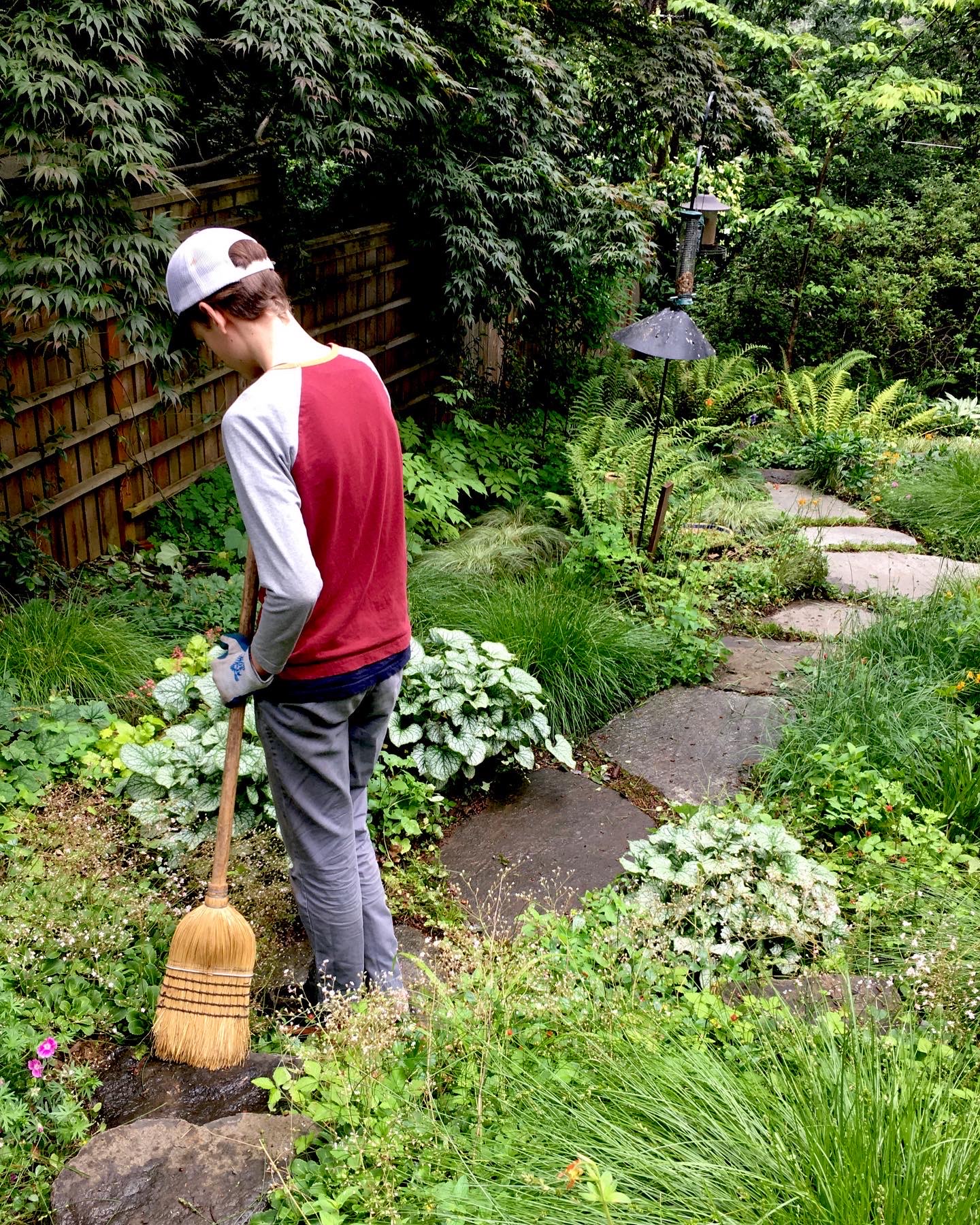
What would it mean to spend the only time you ever get in a way that truly feels as though you are making it count?
—Oliver Burkeman (2021)
Both your feet and your eye need a clear path to follow. Sedges and wood spurge (Euphorbia amygdaloides) creeping into and over paths, poppies flopping post-bloom, fern fronds overarching and obscuring the way through: this is the heart of that “overgrown” or “too full” fear, or the accurate concern that others won’t “get it,” won’t see the garden for the wildness.
To have a naturalistic habitat garden that welcomes all species, including the human animal, tend the edges. Trim back, mow down, shear and shape the lushness off the pathways, away from the edges, shaping a welcoming way, a clear path. Between stepstones, trim flush whatever has crept in. Let volunteers fill the gaps as long as they’re tolerant of grazing. Be the browsing deer widening a swath through the glen. Use a string trimmer if the task is to scale, hand tools will do for you putterers.
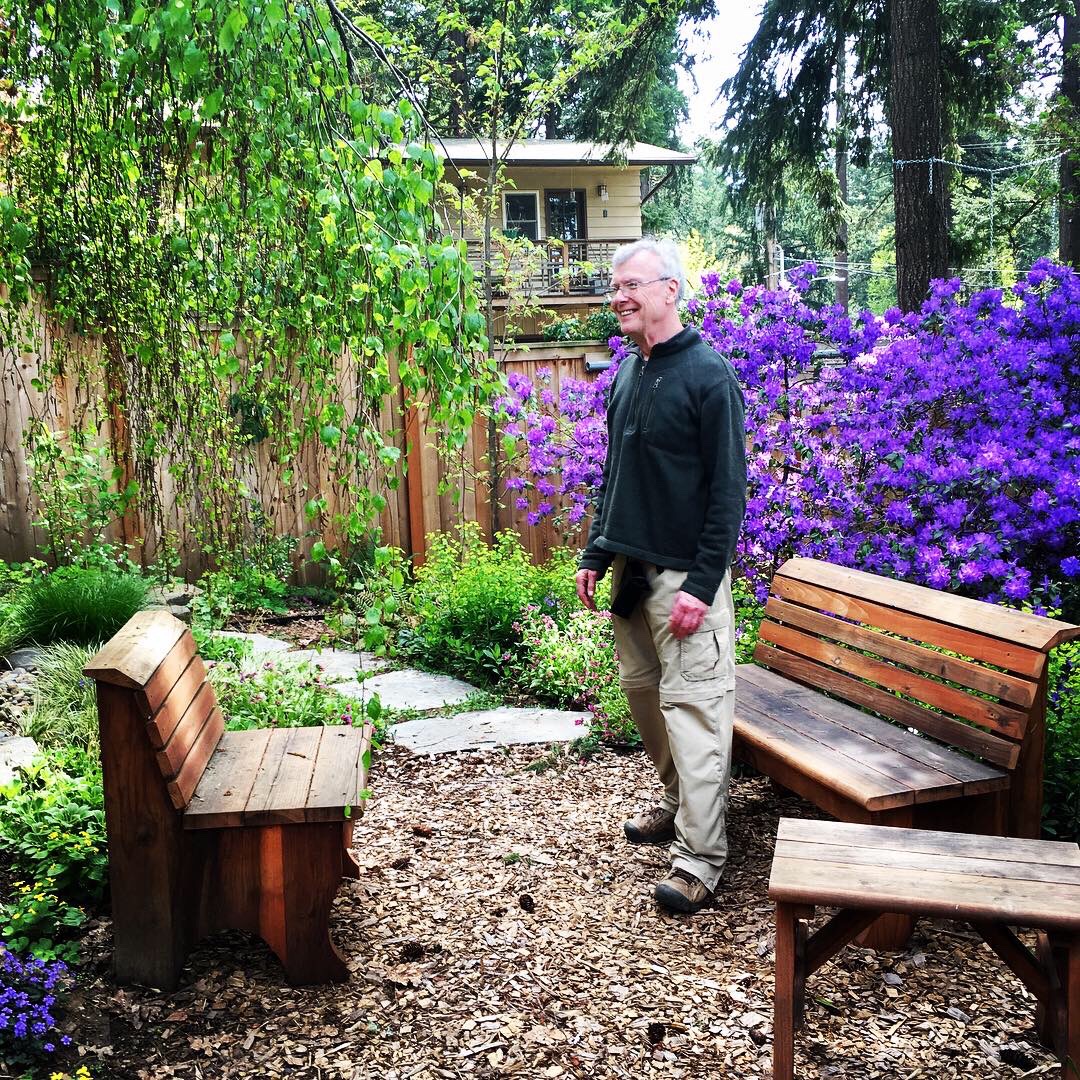
But first, you must prioritize the construction of such well-made paths. This is the second key to low-maintenance gardening: invest in great paths. Excavate, use heavy-duty landscape cloth, and lay your loose materials—wood chips, gravel, decomposed granite (DG)—deep enough to last.
Black metal edging is an excellent guide for maintaining the intended sweep of your woodchip path, curve of your Fleur de Lawn, or straight line of your DG patio. If all you do for maintenance is reveal the definition of the metal-edged line, your garden will become inviting again. Poured concrete is another path option I’m fond of for high traffic areas—nothing is easier to maintain.
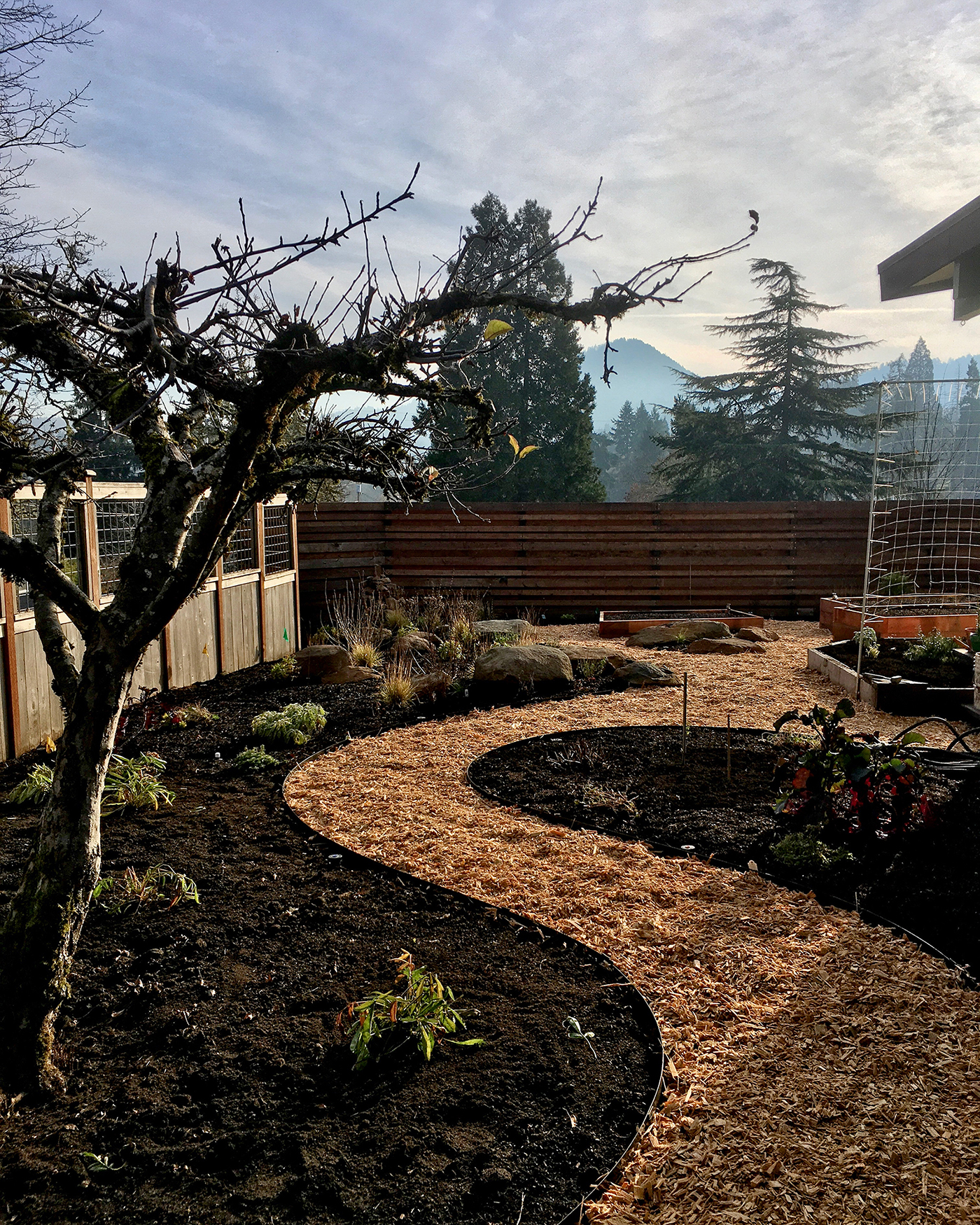
On wilderness explorations far afield, it’s enchanting to squeeze through waist-high sword ferns (Polystichum munitum) or lift an overhanging limb for your companion. But at home, in your own outdoor living room, a clear path, a well-defined edge, and freedom to move about evoke a sense of humanity in your own habitat, your home, your place in nature.
Plan ecological communities or, plant more plants!
Chuck has a large property bordering the West Eugene Wetlands. A place of this scale is inherently more work than a small urban yard. He enjoys the outdoor tasks after working in the office, but when we created gardens around the house, he didn’t want to add a lot more to his chore list. He wondered whether there could be flowers and seasonal beauty without a lot of fuss.
Many years after installing his gardens, I returned to see how things had changed. The once-tiny hinoki falsecypress (Chamaecyparis obtusa ‘Nana Gracilis’) had grown taller than me. Its scalloped limbs twist sculpturally above blooming peonies and iris. What really impressed me was that wherever the garden plants were dense and full, interweaving and layering colors and textures, there were no weeds. None at all. Rich groundcovers of wood sorrel (Oxalis oregana) in the shade, hardy geraniums and violets in the sun, mingled with perennials and shrubs to blanket bare ground, suppressing opportunistic weeds.
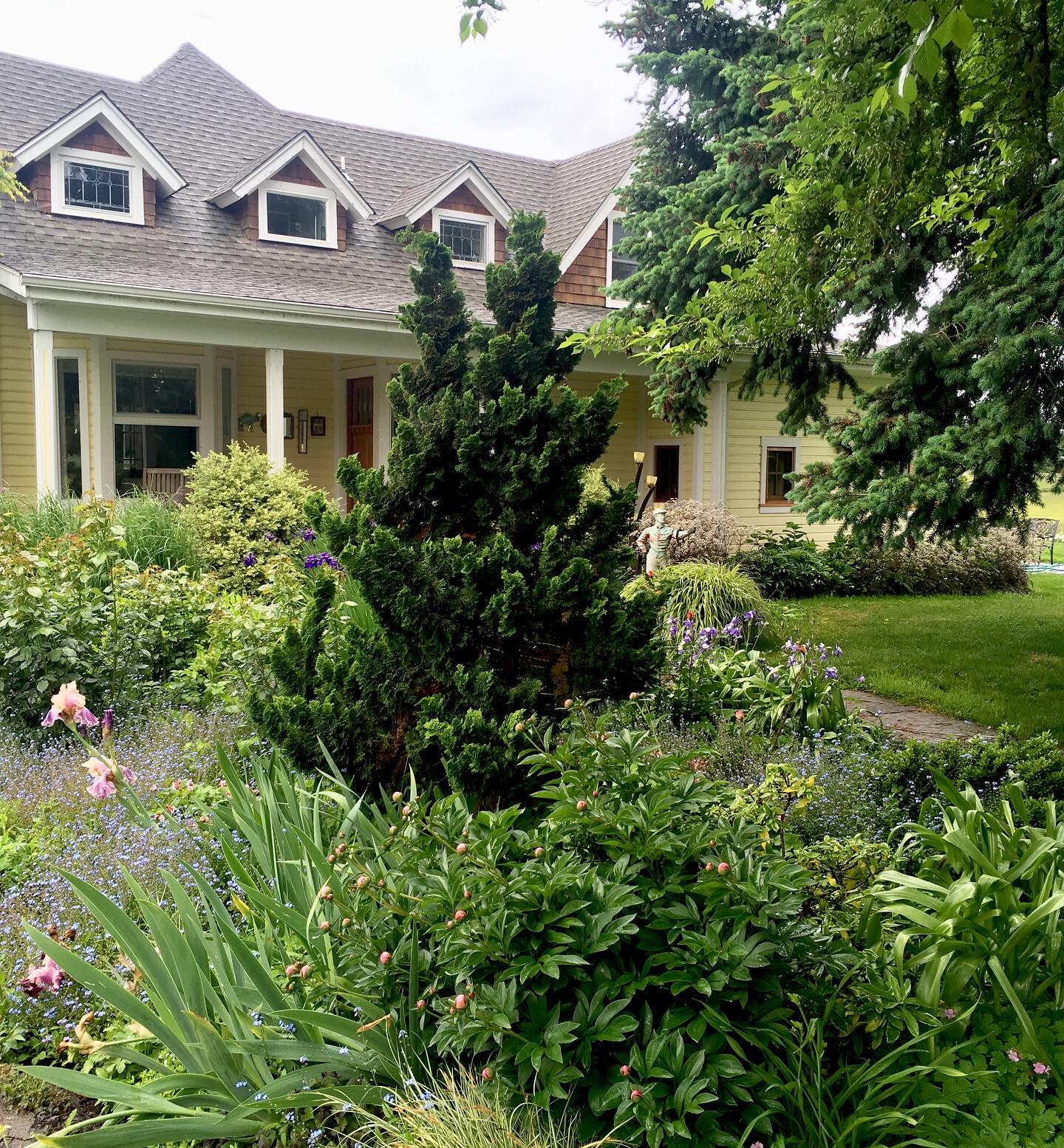
You may be surprised to learn that a low-maintenance garden contains a lot of plants—not sparse with space between sheared specimens. Especially in the Pacific Northwest, where we enjoy a mild climate, bare ground means weeds.
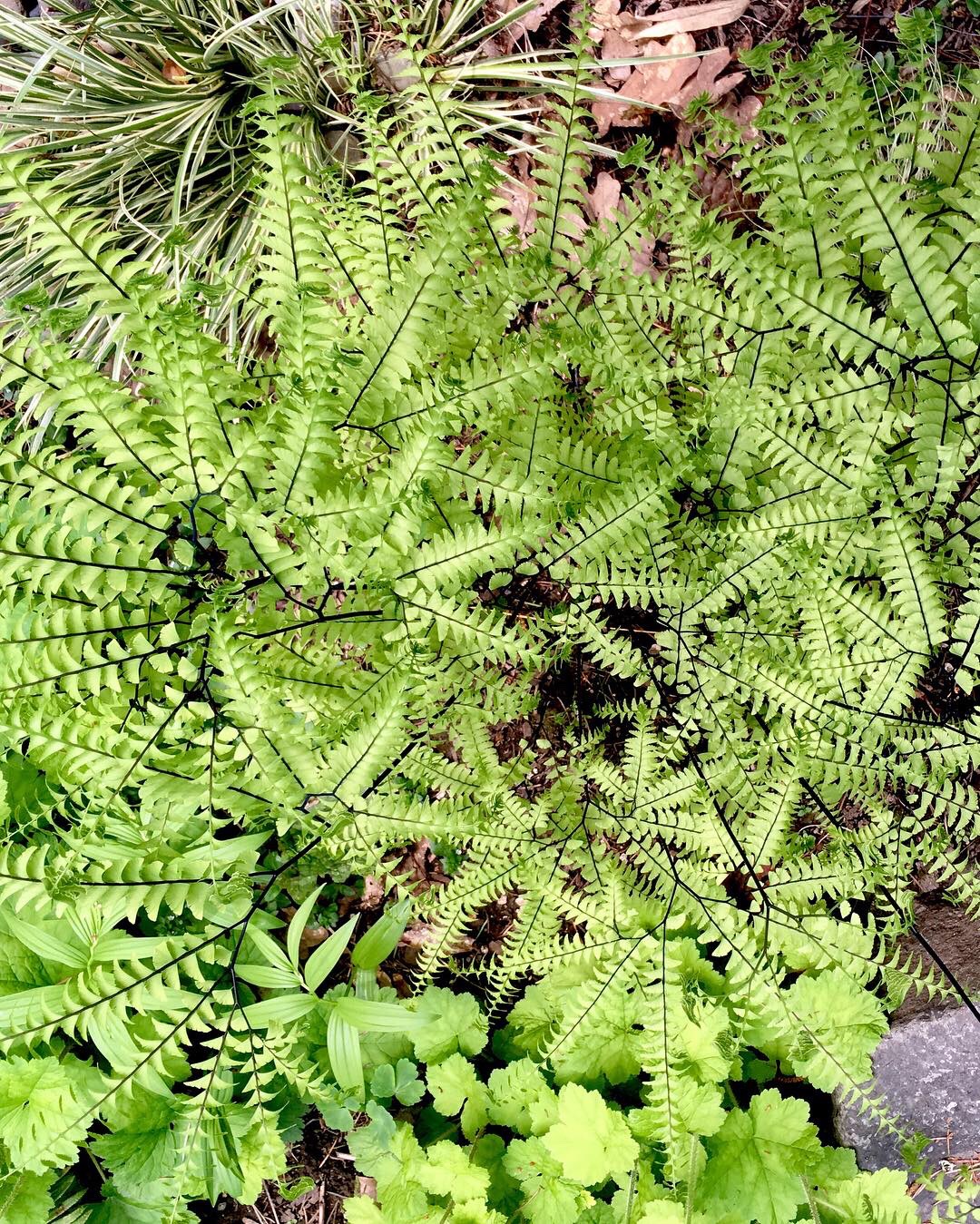
Do you ever look at a garden, admire it, then immediately think, “that looks like a lot of work”? What about a stunning scene in nature: a windswept coastal forest, a wetland meadow, or a high mountain lake circled by huckleberries and firs—does that also look like work? What’s the difference? A community of plants filling every niche from down low, hugging the ground, to overhead, casting shade and autumn leaves, mimics nature. Dense planting offers waves of seasonal color: early spring wood anemones (Anemonoides nemorosa) pillowing around the ankles of emergent hellebores (Helleborus) give way to the arching fronds of ferns and, later, tall stands of toad lilies (Tricyrtis) delight with their speckled blooms.
This is the third, and the most garden-rich, key: plan layered plant communities informed by ecology as much as aesthetics. If you already have a nice garden, but complain about weeds: plant more plants! Give special attention to the ground-hugging greenery. In Chuck’s garden, it’s the high diversity of groundcovers that quiet the weed invasion, allowing only leisurely weekend afternoons to keep it up.
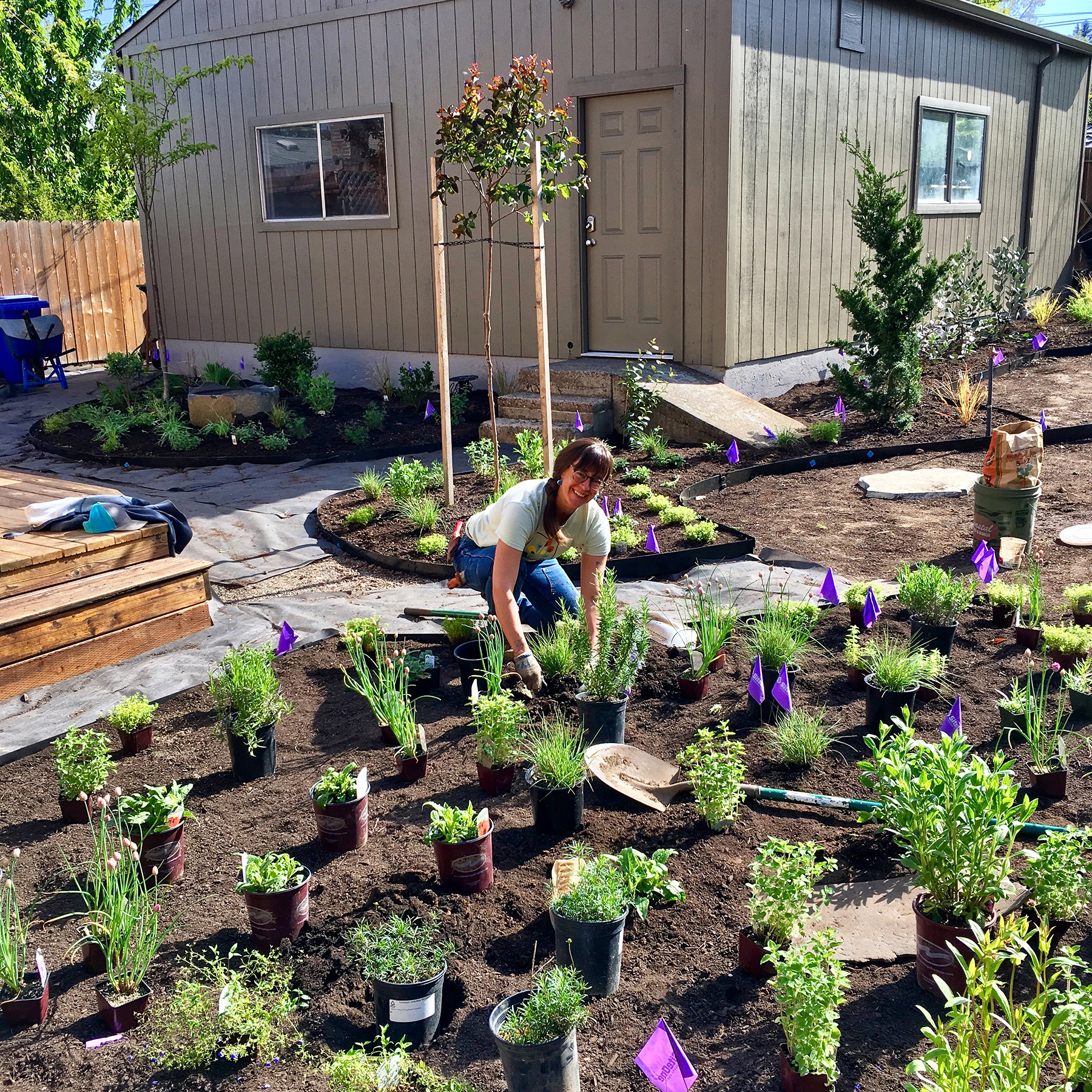
But all a plan is – all it could ever possibly be – is a present-moment statement of intent.
—Oliver Burkeman (2021)
Back to the beginning of this journey, even with your most well-thought-out planting plan in place, step back and see what happens as it naturalizes, as plants move around and the design changes over time. Release control of the design, intervening only when bare ground opens up or when one plant gallops suffocatingly over too many neighbors. Isn’t that the heart of why you love to garden? The observation followed by small inputs, the relationship between you and the plants, you as a part of the community just as much as the woodland strawberry and the arching limbs of the flowering cherry?
Regular, lazy puttering
Tammy is a client I adore whose garden we installed only recently, one with bare ground still between the new plants, one with weeds popping up under sun and rain. With the love of a new mother for her new baby, she is out there tending it. “While weeding, I had many lovely conversations with neighbors as they walked down the street and everyone loves the yard,” she texted me, along with a question about which mulch to get to top up where the neighbors’ newly seeded lawn spilled into her lawn-free bed.
Two things about this text: one, the chance to connect, to talk to neighbors, to talk to the growing things, to engage with life—this is why gardeners keep gardening. Two, intensive weeding with diamond hoe, back bent to the rhythmic shuffle of erasure, is only for the establishment phase. I picture Tammy out there in three years, once the ground-covering sedums, kinnikinnick, and creeping wild lilac (Ceanothus) have romped all around and the weed seed load diminished. I see her upright, wandering the margins, bending occasionally to pluck. I see her puttering, enjoying the laziness of the weekend with a small smile on her lips as the task of gardening shifts to a more passive, observational mode, rather than the focused sweat of the establishment phase.
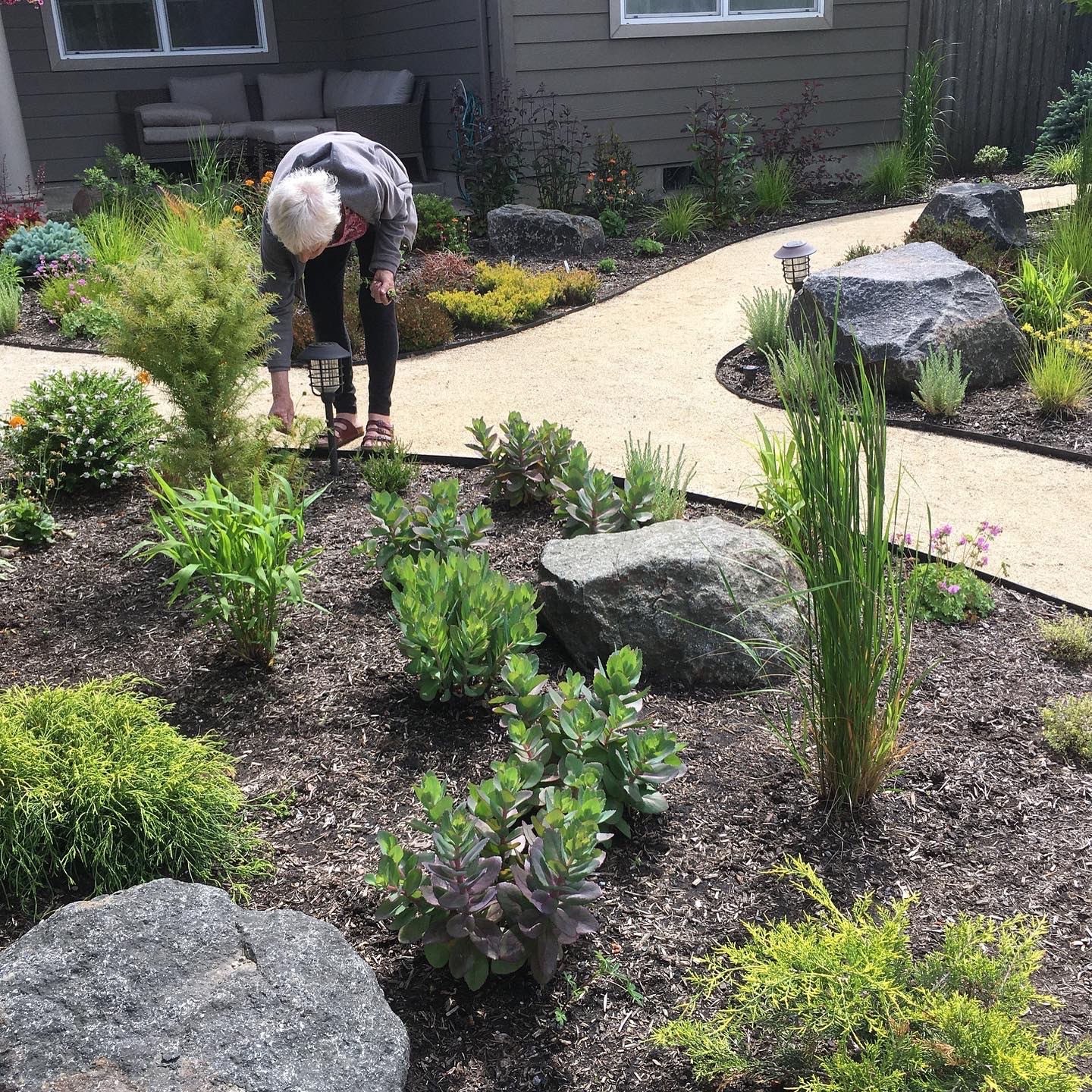
In my own small garden, I hung the clothes on the line and spied an errant lemon balm (Melissa officinalis), a smothering opium poppy (Papaver somniferum) and a Himalayan blackberry (Rubus armeniacus) cane arching over the camellia. Clothes swaying in the sun, I wandered and plucked, discovering Ithuriel’s spear (Triteleia laxa) blooming amidst the profusion and a crab spider (Thomsidae) stalking on the yarrow (Achillea millefolium). For the blackberry, I needed pruners from my car out front where rambling akebia tendrils waylaid me. Snip, snip and they lay on the path like seaweed washed ashore, a mess of pale green spaghetti, easily gathered into the yard debris bin. On the way there, a nipplewort (Lapsana communis) in flower, yank, and another. That’s it. All the front garden needs tonight. Back to the blackberry, whose trimmings I place along the fence line to deter cats, dogs, opossums from forever trampling and fouling the perimeter.
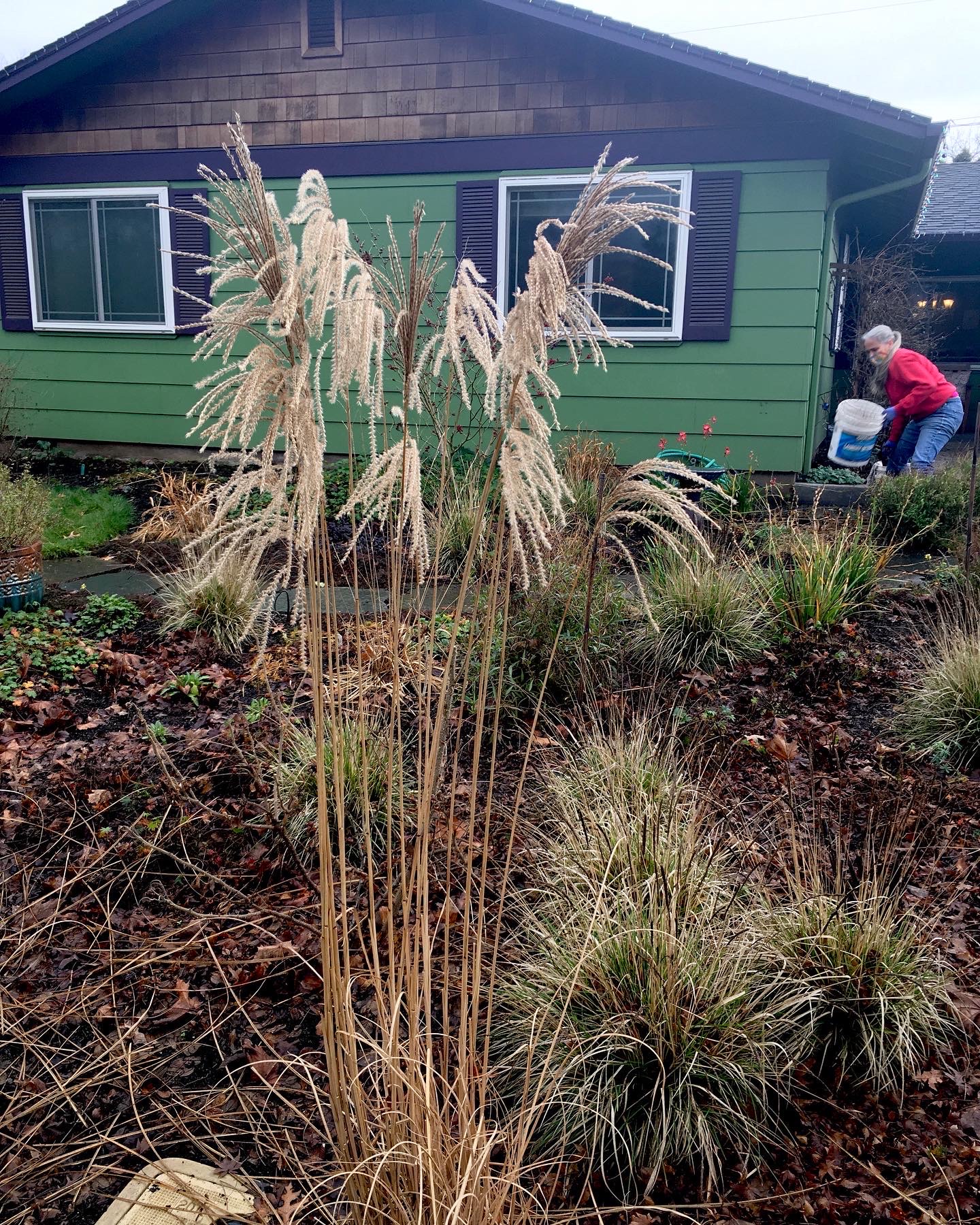
This is the ease of the lazy gardener, moving from small task to small task, alive in the flow of time, and then done. A light but regular presence of gardener in garden is all it takes to allow the next moment to come—the moment of rest with a sparkling beverage, a companion, and the satisfaction of the past fifteen minutes spent outdoors moving, touching, tending. All is well in the world.
A life devoid of all problems would contain nothing worth doing, and would therefore be meaningless.
—Oliver Burkeman (2021)
Wandering your garden, finding yourself in each moment as it comes, attending, becomes meditation rather than maintenance. Synchronized with the many species of your garden, time ceases to exist. The fourth key of low-maintenance gardening is to regularly practice lazy puttering. Small problems are squelched, giving your stroll meaning, connecting you to nature. Importantly, your garden thrives. Don’t underestimate the effect lazy puttering can have on the wellbeing of your plantings. It directly mirrors the positive effect to your own wellbeing.
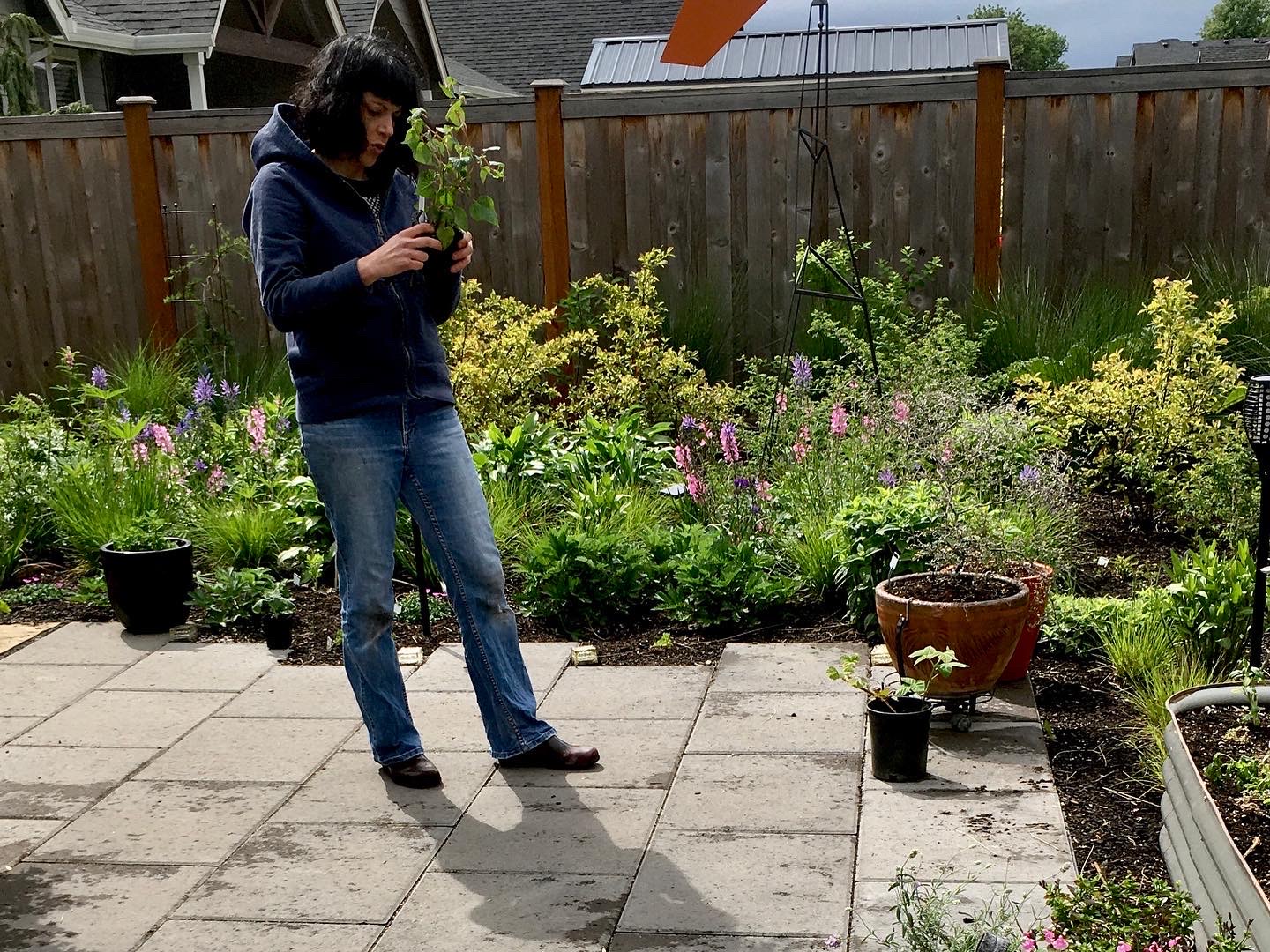
Conclusion
With a delighted cackle, a friend claims her garden has gone feral. Her carefully chosen plantings mingle with her impulse additions, finding an ebbing and flowing rhythm of summer profusion as spring declines. A feral garden is one that has naturalized, one that is allowed to grow as it will. It’s not controlled nor maintained at a static conception of perfection, but rather guided, lightly edited, and supplemented. It’s observed. It’s respected. To let your garden go feral feels freeing. You’ve created something and released it to the world to become what it will. And, like raising a teenager and letting them make mistakes as they stretch out into the world away from you, you accept a certain amount of weirdness, of surprise, of wonder at what arises. Plant combinations you’d never have imagined pop up: self-seeding white foxglove (Digitalis purpurea) arrows through a patch of red and yellow Western columbine (Aquilegia formosa); a spontaneous oregano hybrid compliments the rose.
Embracing naturalized patterns as they billow within your strong framework of paths, planting more plants to fill all niches, and attending to the growth with lazy passes—that’s a recipe for joy. And what do you really want from your time in the garden more than joy?
Resources
Burkeman, Oliver. 2021. Four Thousand Weeks: Time Management for Mortals. New York: Farrar, Straus and Giroux.
Foster, Charles. 2016. Being a Beast: Adventures Across the Species Divide. New York: Henry Holt and Company.
Share:
Social Media
Garden Futurist Podcast
Most Popular
Videos
Topics
Related Posts
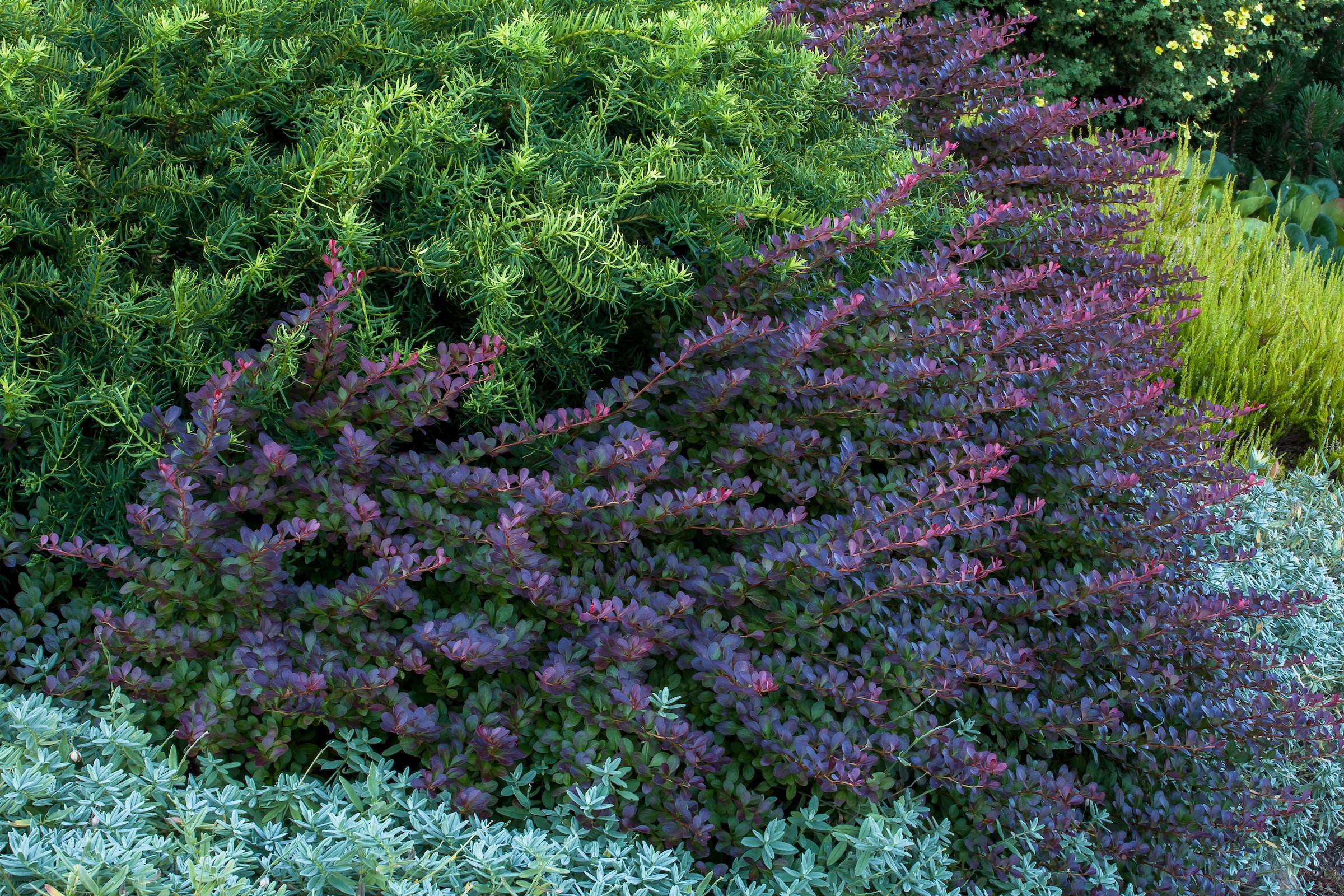
Readily Available Low-Water Plants for a Warming Climate
Fall 2022 Al Shay is the manager of the Oak Creek Center for Urban Horticulture on the campus of Oregon State University (OSU) in Corvallis.
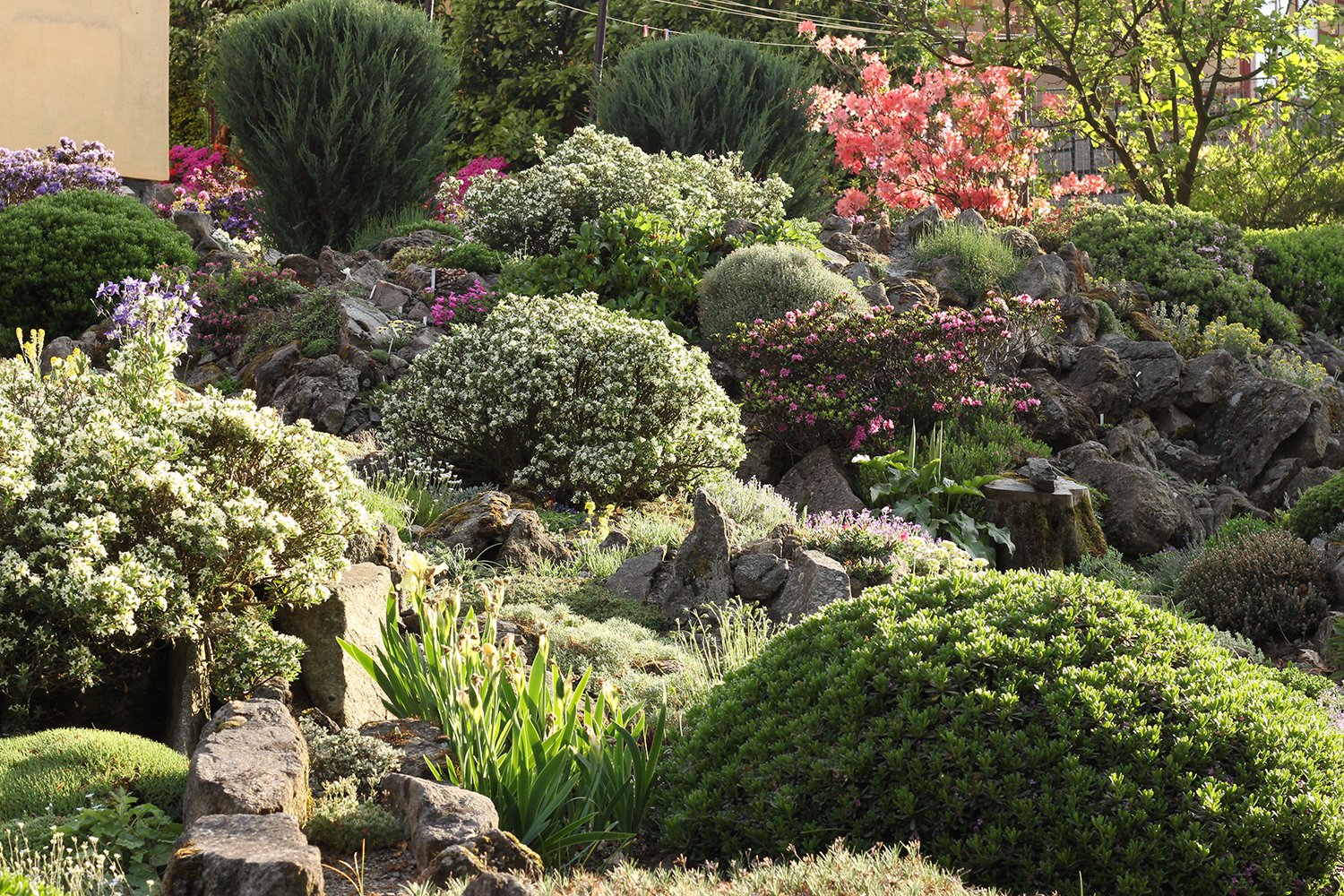
West Coast Rock Gardening
Fall 2022 Foreword by Paul Spriggs Rock gardening has historically been popular in the Pacific Northwest. Many European immigrants brought their rock gardening culture with

Invasive Plants Are Still Being Sold: Preventing Noxious Weeds in Your Landscape
Autumn 2022 With so many beautiful ornamental plant species and cultivars throughout California and the Pacific Northwest, how do you decide which ones to include

Garden Design in Steppe with Transforming Landscapes with Garden Futurist Emmanuel Didier
Summer 2022 Listen to full Garden Futurist: Episode XVII podcast here. Emmanuel Didier, Principal and Creative Director at Didier Design Studio is a leading figure











Responses